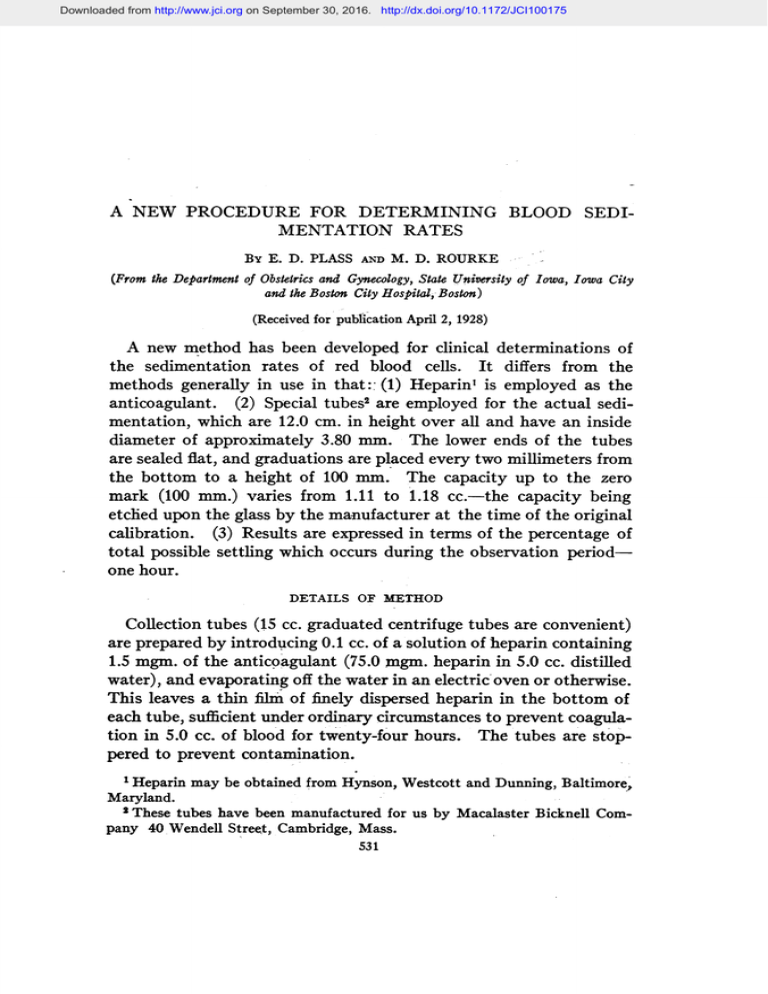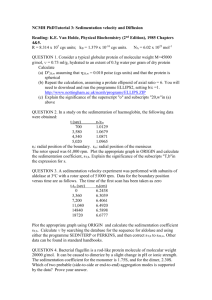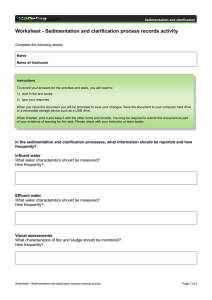methods generally in use in that:: (1) Heparin` is employed as the
advertisement

Downloaded from http://www.jci.org on September 30, 2016. http://dx.doi.org/10.1172/JCI100175 A NEW PROCEDURE FOR DETERMINING BLOOD SEDIMENTATION RATES By E. D. PLASS AND M. D. ROURKE (From the Department of Obstetrics and Gynecology, State University of Iowa, Iowa City and the Boston City Hospital, -Boston) (Received for publication Apr1l 2, 1928) A new method has been developed for clinical determinations of the sedimentation rates of red blood cells. It differs from the methods generally in use in that:: (1) Heparin' is employed as the anticoagulant. (2) Special tubes2 are employed for the actual sedimentation, which are 12.0 cm. in height over all and have an inside diameter of approximately 3.80 mm. The lower ends of the tubes are sealed flat, and graduations are placed every two millimeters from the bottom to a height of 100 mm. The capacity up to the zero mark (100 mm.) varies from 1.11 to 1.18 cc.-the capacity being etched upon the glass by the manufacturer at the time of the original calibration. (3) Results are expressed in terms of the percentage of total possible settling which occurs during the observation periodone hour. DETAILS OF METHOD Collection tubes (15 cc. graduated centrifuge tubes are convenient) are prepared by introducing 0.1 cc. of a solution of heparin containing 1.5 mgm. of the anticoagulant (75.0 mgm. heparin in 5.0 cc. distilled water), and evaporating off the water in an electric oven or otherwise. This leaves a thin Elm of finely dispersed heparin in the bottom of each tube, sufficient under ordinary circumstances to prevent coagulation in 5.0 cc. of blood for twenty-four hours. The tubes are stoppered to prevent contamination. 1Heparin may be obtained from Hynson, Westcott and Dunning, Baltimore' Maryland. 2 These tubes have been manufactured for us by Macalaster Bicknell Company 40.Wendell Street, Cambridge, Mass. 531 Downloaded from http://www.jci.org on September 30, 2016. http://dx.doi.org/10.1172/JCI100175 532 BLOOD SEDIMENTATION RATES When a specimen of blood is desired it is drawn directly into the centrifuge tube by means of the arrangement indicated in figure 1, or is taken first into a syringe and then introduced into the tube containing the heparin. The latter procedure permits blood to be - U, .0 U 0 u 0) E (r) FIG. 1. BLOOD COLLECTION TUBE AND NEW BLOOD SEDIMENTATION TUBE taken at the same time for blood chemistry or for other ..purposes where its mixture with heparin might be a distinct disad-vantage. In any case thorough mixture with the heparin must be secured. Shaking may.be resorted to, since aeration of the blood has little effect upon the rate of sedimentation. When very accurate deter- Downloaded from http://www.jci.org on September 30, 2016. http://dx.doi.org/10.1172/JCI100175 E. D. PLASS AND M. D. ROURKE 533 minations are essential, collection under oil has been adopted, but for clinical purposes is not necessary. With a pipet drawn out to a long, fine point so that -it 'may pass easily to the bottom of the sedimentation tubes and graduated roughly at 1.25 cc., a part of the specimen is now transferred to a sedimentation tube so that the meniscus is at the zero mark. The tube is plated in a vertical position and allowed to stand undisturbed for one hour, when a reading of the height of the clear plasma column is noted on the millimeter scale. The tube is now centrifuged for 20 minutes at a speed of approximately 2500 r.p.m., and the height of the plasma column read again. This latter reading gives directly the percentage of plasma in the specimen, or the total possible settling in millimeters. By dividing the millimeters of clear plasma obtained after one hour settling 'by the millimeters of clear plasma after centrifuging, and multiplying by 100 one obtains directly the percentage of total possible settling which has occurred in one hourthe final value. If the top of the original blood column = 0 the top of the cell column after the end of 1 hour = 20 mm. and the top of the cell column after centrifuging = 60 mm., *w X 100 = 33.3 per cent of total possible settling in 1 hour. RESULTS The sedimentation rates-_of certa-in presumably-healt-hyyou-Tig adults (22 men and 45 women) have.been determined by this method. with the results given in table 1. It should be noted that the sedimentation rate is higher in women (average-30.9 per cent) than in men (average- 11.4 per cent), a fact which has been noted by all previous investigators. It is also apparent that the plasma volume percentage is higher in women (average-56.5 per cent) than in men (average-50.8 per cent), an observation which partially explains the more rapid settling in the former. We have been unable to determine any definite relation between- the sedimentation rate in women and the period in the menstrual cycle at which, the specimen was obtained. Of the six women who had sedimentation rates above 50 per cent, one had just begun to menstruate and one was about due, while the others reported Downloaded from http://www.jci.org on September 30, 2016. http://dx.doi.org/10.1172/JCI100175 534 BLOOD SEDIMENTATION RATES TABLE 1 Normal values Case number Plasma after 1 hour Plasma after centrifuging Piercsetatglin io1 thour Healthy young men 1 2 3 4 5 6 7 8 9 10 11 12 13 14 15 16 17 18 19 20 21 22 mm. mm. per cent 6 6 2 9 6 5 4 6 6 6 2 5 9 5 5 10 6 1 11 9 3 6 49 52 12 12 4 4b 52 48 50 52 51 49 50 52 53 52 50 b1 54 51 48 53 50 49 53 17 1? 10 8 12 12 12 4 9 17 10 10 19 12 2 21 18 6 11 Healthy young women 1 2 3 4 5 6 7 8 9 10 11 12 13 14 15 14 23 22 32 22 10 20 23 15 23 8 32 2S 18 7 54 59 58 62 57 53 61 58 56 58 57 56 57 55 58 26 39 38 52 39 19 33 40 27 40 14 57 49 33 12 Downloaded from http://www.jci.org on September 30, 2016. http://dx.doi.org/10.1172/JCI100175 535 E. D. PLASS AND M. D. ROURKE TABLE 1-Coxtinued Case number Plasma after 1 hour Plasma after centrifuging l s ttalhos- Healthy young women-Continued mm. mm. 16 17 18 19 20 21 22 23 24 25 26 27 28 29 30 31 32 33 34 35 36 18 17 20 20 32 26 18 12 34 29 15 8 19 5 12 11 25 32 20 5 57 54 58 54 55 55 56 57 59 56 55 52 56 54 54 53 59 57 7 37 38 10 8 8 21 14 14 9 15 10 56 54 56 58 58 55 62 39 40 41 42 43 44 45 57 57 57 58 56 per cen 32 31 34 37 58 47 32 21 58 52 27 15 34 9 22 21 42 66 35 9 13 14 14 14 36 25 23 16 26 18 the onset of the previous period 13 days, 21 days, 6 days, and 25 days earlier, respectively. Repeated determinations on the blood from normal individuals has shown that the sedimentation rate varies only very slightly from week to week. By reason of the range of values obtained upon our series of healthy young women, supported by our clinical experience with the test, we have placed the upper limit for normal in women at 65 per cent, Downloaded from http://www.jci.org on September 30, 2016. http://dx.doi.org/10.1172/JCI100175 536 BLOOD -SEDIMENTATION RATES. and.look upon higher- values.as indicating -the.presence of some, physiological or pathological condition. associated with abnormally high-sedimentation-rates. Our experience with the blood of healthymen leads us to place the upper limit of normal at approximately 25 per cent. DISCUSSION Heparin is used as the anticoagulant because we have shown that it does not affect the settling rate or the cell volume in any concentration which might reasonably be used to prevent coagulation. The inorganic anticoagulants usually employed (sodium citrate and potassium oxalate) retard the sinking of the cells in proportion to their concentration, and unless used in isotonic solutions interfere with the size of the blood cells and so disturb the plasma volume readings. Moreover, when they are used in solution and a certain amount of blood is specified to be drawn into a given amount of anticoagulant solutions (Linzenmeier (1) and Westergren (2) methods, and their modifications) in a graduated syringe, accurate mensuration becomes difficult, if not practically impossible. As Bbnniger and Herrmann (3) have emphasized, even absolute accuracy would not be of much value, since the fluid introduced actually dilutes the plasma, the amount of which in a given specimen of blood is unknown when the dilution is made, unless a preliminary hematocrit is done. If a blood contains 50 per cent of cells by volume and is diluted 4 parts to 1 part of anticoagulant solution, the plasma is diluted 2:1, whereas if the blood contains only 25 per cent of cells by volume and the same dilution is effected, the plasma becomes diluted 3: 1. Certainly the use of an anticoagulant solution introduces factors-which can-not- be controlled but which- have a&-defi-nite effect. When even accuracy of dilution is so obviously impossible, it beccmes apparent that the whole determination, when carried out by the more commonly used methods, is little more than 'an approximation. By the use of dried heparin, dilution is, entirely avoided, and its attendant difficulties and errors are eliminated; Rubin and Smith (4) have used.dry hirudin as an anticoagulant with the assumption that it avoids the errors inherent in the inorganic antico-agulants. ]Bonniger- (5), on the other hand, reports that hirudin Downloaded from http://www.jci.org on September 30, 2016. http://dx.doi.org/10.1172/JCI100175 E. D. PLASS AND M. D. ROURKE 537 blood generally settles more slowly than untreated blood, and that the sedimentation rates in hirudinized bloods and in oxalated bloods for the most part agree. We have found in a few experiments that bloods taken over hirudin settle somewhat more slowly than those taken over heparin, even though the slowing is not as marked as when solid oxalate is employed. Heparin has one disadvantage-it costs about one cent per milligram. The total length of the column of blood is probably the most important of the physical factors involved and yet relatively little attention has been paid to securing uniformity in this respect. Sedimentation tubes of the size we use provide for a column of blood of the same height in all tests, and are, moreover, of such a caliber that the accelerating effect of capillary action is small. The total amount of blood which we use is moderate and duplicate determinations can easily be made from an original sample of 3 to 5 cc. We have found that duplicate readings agree within such a small percentage that for clinical purposes a single reading only is made. One hour has been selected as the most useful period for a single reading, since at that time sedimentation in normal bloods is damped neither by preliminary agglutination nor by packing. As a close approximation, it may be said that when the plasma volume is 60 per cent or less a retardation of the settling rate becomes apparent by the time the top of the cell column has reached the 40 mm. mark. Therefore, in rapidly settling bloods packing has usually become effective within the one-hour period, but is of no importance if 'one takes the view that the test is of more value as a negative finding, i.e., a slow sedimentation rate is more accurately evaluated than is a rapid sinking. The advantage of making readings after a given time interval rather than determining by frequent readings the time necessary for the blood to settle a certain number of millimeters (Linzenmeier -(1) method) is obvious. Most recent workers have adopted this point of view, although the Linzenmeier method, which is perhaps used more than any other in this country, is based upon the other principle. By centrifuging the blood in the sedimentation tubes at the end of the one-hour period of- settling, we determine directly and with sufficient accuracy the total plasma volume, and are thus in a posi- Downloaded from http://www.jci.org on September 30, 2016. http://dx.doi.org/10.1172/JCI100175 538 BLOOD SEDIMENTATION RATES tion to correct our results partially for variations in cell volume, which have a pronounced effect upon the rate of sedimentation. A reduced cell volume increases the rate of settling even though other factors which may influence this rate are not disturbed. By diluting centrifuged cells with their own plasma to different ceU volumes and then determining the rate of sedimentation, this fact can be demonstrated easily. This means practically that every patient with an anemia of any consequence will have a rapid sedimentation rate, even though no other cause leading to rapid settling may be operative. Obviously this confuses the interpretation of results and is particularly annoying if one emphasizes especially the value of a normal settling rate. By introducing in our calculation the plasma volume percentage as determined by centrifuging the blood (blood volume minus cell volume) as representing the total possible settling, and computing the sedimentation rate as the percentage of total possible settling occurring during the one-hour observation period, we are avoiding some of this difficulty. An alternative procedure, the compilation of a chart showing the settling of different concentrations of normal cells in their own plasma, would undoubtedly be more accurate, but the method adopted is somewhat simpler and has been shown by a year of clinical test to be quite satisfactory. Our experience does not agree with that of Rubin and Smith (1. c.), that, " . . . . the cell volume obtained by hematocrit bears a fixed ratio to that obtained by the spontaneous settling of the cells in twenty-four hours. Among 10 normal men in our series, the settling in 24 hours represented from 62 to 77 per cent of the total possible settling (hematocrit), whereas among 35 women it ranged from 65 to 95 per cent. In general, it may be said that the amount of spontaneous settling bears a closer relationship to the sedimentation rate than to the cell volume,-the more rapidly the cells settle, the more nearly complete is the spontaneous settling in 24 hours. In pathological bloods, the variations are even greater than in the normals quoted. Moreover, we prefer to have the final reading available as soon as possible, and for that reason alone would choose centrifugalization. The complete data, upon which some of the statements in this paper are based, will be presented in a later communication, as will also the results of the clinical application of the test in a large series of obstetrical and gynecological patients. Downloaded from http://www.jci.org on September 30, 2016. http://dx.doi.org/10.1172/JCI100175 E. D. PLASS AND M. D. ROURKE 539 SUMMARY A new method is advanced for the determination of sedimentation rates as a clinical procedure. The technic described obviates some difficulties inherent in the methods now in common use. Heparin is employed as the anticoagulant, special tubes are used giving a column of blood 100 mm. high, and results are expressed as the percentage of total possible settling (plasma volume percentage determined by centrifuging), which occurs during the one-hour period of observation. The results obtained on the bloods of 22 normal men and of 45 normal women are reported. 1. 2. 3. 4. 5. BIBLIOGRAPHY Linzenmeier, G., Miinchen. med. Wchnschr., 1923, lxx, 1243. Die Senkungsgeschwindigkeit der roten Blutk6rperchen und ihre praktische Bedeutung. Westergren, A., Klin. Wchnschr., 1922, i, 1359. Ueber die Stabilitatsreaktion des Blutes, nebst vergleichwerten bei verschiedener Methodik. Einige Mitteilungen uiber fortgesetzte Untersuchungen. B6nniger, M., and Herrmann, W., Klin. Wchnschr., 1923, ii, 744. Blutkorperchensenkungsgeschwindigkeit und -Volumen. Rubin, E. H., and Smith, N. M., Arch. Int. Med., 1927, xxxix, 303. Relation of hemoglobin, cell count and cell volume to the erythrocyte sedimentation reaction. Bonniger, M., Deutsch. med. Wchnschr., 1927, liii, 269. Ueber die Methode der Blutsedimentierungsreaktion.


